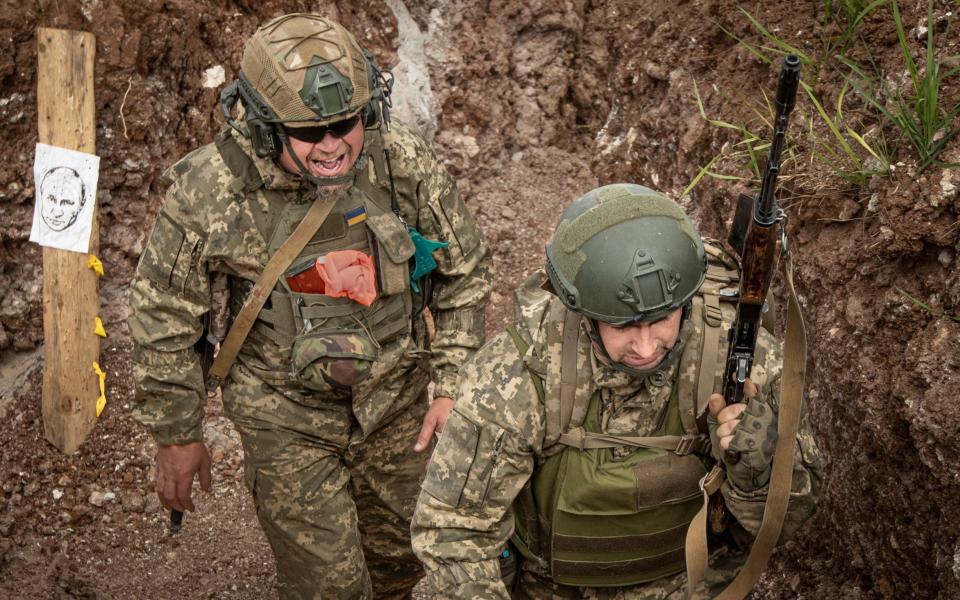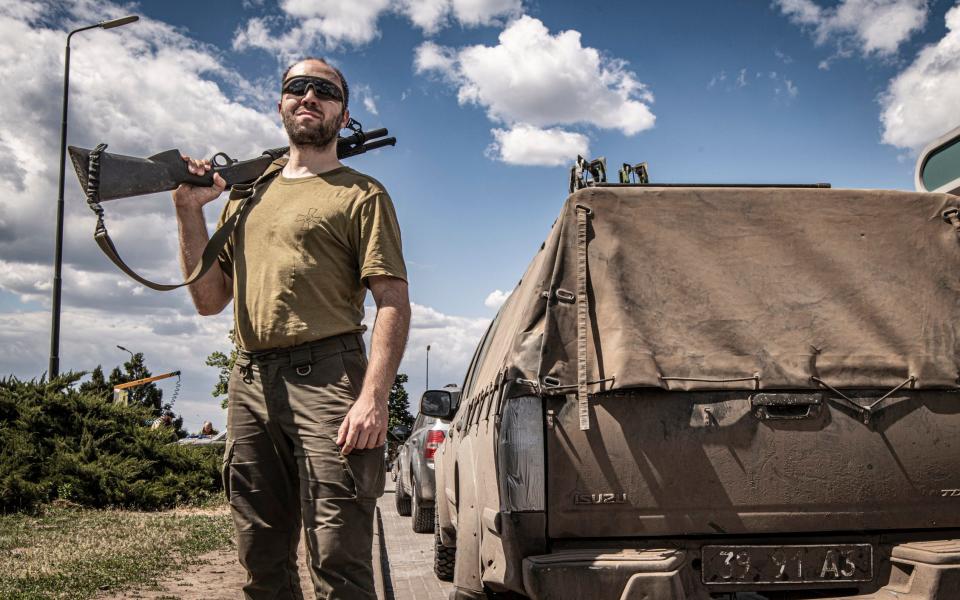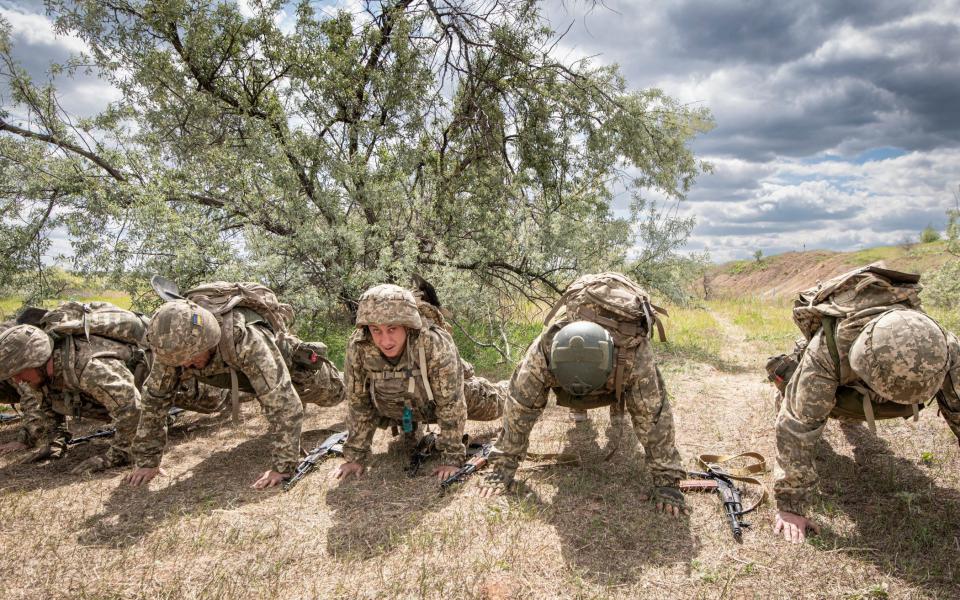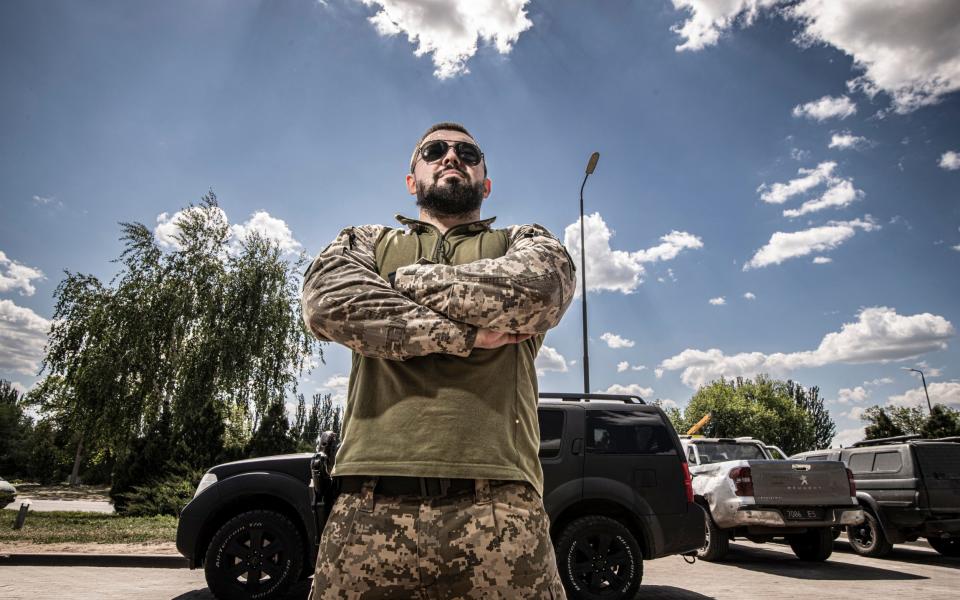Gennady Daskal is no stranger to blood and guts. Until last month, the 27-year-old was working in an abattoir in central Ukraine, killing pigs and cows for a living. Now, after being conscripted, he is preparing to enter a very different kind of slaughterhouse. As part of a rookie infantry assault unit, he is being trained up for the Donbas frontline – the gruelling combat zone that many nickname the “meatgrinder”.
“I got my draft papers, so here I am,” he told The Telegraph, as he practised shooting rifles and grenade launchers at a range in a Donbas clay-pit. “Of course I’m worried, because I know many guys who’ve died already – maybe 10 or 20. But what can you do?”
Like other conscripts in the 22nd Mechanised Brigade, Mr Daskal tries to channel his inner warrior. His callsign is Pitbull, and he flashes a cheery, gold-toothed grin. But asked about his wife and children back home, and suddenly he chokes with emotion. “Of course she’s worried,” he says, tears forming. “And the kids want me to come back as soon as possible.”

Right now, the odds of Mr Daskal’s children getting their wish are not great. For one, life expectancy is short in front line infantry units, where casualty rates can be as high as 70 per cent dead or wounded. For another, an end to the war now seems further away than ever, with Russia intensifying its Donbas campaign and opening up a new front line last week on the north-east border around Kharkiv.
That Ukraine is facing its toughest period since the war started was acknowledged last week by Anthony Blinken, the US Secretary of State, who admitted during a visit to Kyiv that things were “very difficult”.
He was there to demonstrate America’s continued support after Washington finally signed off a $60 billion aid package, following nine months of political deadlock.
Manpower shortage
But lack of weapons is just one of Kyiv’s problems right now. Equally worrying is the growing shortage of soldiers to use them. As Kyrylo Budanov, Ukraine’s intelligence chief, admitted last week: “All our forces are either in Kharkiv or in Chasiv Yar. We don’t have any reserves.”
Hence Ukraine now resorting to tough new mobilisation measures, as death, injuries and combat fatigue sap its front lines. New laws that come into effect on Saturday increase penalties for draft dodgers, while the draft age has been controversially lowered from 27 to 25.


But conscription isn’t just affecting the young, free and single, as a glance at the 22nd’s new recruits makes clear. Some are men in their 50s who should be contemplating retirement and struggle to do more than a few press-ups when asked. Others like Mr Daskal are family men, who have had to tell their young children that Daddy is not going to be around for a while.
“I have a six-year-old boy – he’s too young to understand everything, but he knows there’s a war and has been told that his father’s going to be a hero,” says Oleh Gorpenyuk, 38, a factory engineer. “We didn’t talk much about the war before I left – I just played lots of games with him and tried to spend as much time together as possible.”
The 22nd’s rookies are likely to get their first taste of combat around Chasiv Yar, which Moscow’s forces have had their eye on ever since capturing Bakhmut, 10 miles east, this time last year.
A run-down clay-mining town of 10,000, its sole claim to fame used to be that it was the birthplace of the late Joseph Kobzon, a Communist-era crooner dubbed the “Soviet Frank Sinatra” (not least because of his alleged links to organised crime).


Like Bakhmut, Chasiv Yar has now acquired a notoriety as a Donbas Passchendaele, combining the trench horrors of the First World War with 21st-century drone warfare. Both sides in the conflict now rely massively on first-person-view (FPV) drones: explosive-carrying mini-drones that can stalk individual soldiers across the battlefield like giant, deadly mosquitoes.
Last week, Ukrainian troops stationed in Chasiv Yar said that despite the US military aid tap being turned back on, they were still being outgunned both in terms of drones and artillery.
Wavering morale
“The Russians are pushing very hard and recently we’ve had to fall back from our positions,” said Junior Sgt Nikita, brandishing a sporting shotgun that he uses to shoot down Russian FPVs. “Morale is up and down, we have little victories and little defeats, but we have nothing like enough new people joining the ranks.”
In such an environment, he said, fortune favoured only the suicidally brave – or the simply suicidal. “Because the Russians have more troops and tanks than us, they can afford to do kamikaze attacks, and we just don’t have enough artillery to stop them.”
Because of the FPV threat, most frontline soldiers now spend nearly all their time in dug-outs – cramped, earth-walled shelters that are freezing in winter and sweltering in summer. They feel like being in a ready-dug grave, and sometimes prove to be just that, thanks to Russia’s new 250-kilogram glide bombs, which are powerful enough to penetrate deep underground.


In such an environment, it is no surprise that today’s Ukrainian army now also has psychologists as well as old-school chaplains.
“A lot of people have just seen too many dead or injured,” says Julia (not her real name), 28, the 22nd’s resident shrink, who operates from a practice in an abandoned home. “It’s especially traumatic for people who’ve recently mobilised and haven’t yet experienced combat, then suddenly they see something horrible.
“We remind them to think of themselves, not of comrades who’ve been killed, as if they live only in that world of the dead, their minds can get stuck there forever.”
Tough as it is on the newcomers, longer-serving troops are desperate for others to take over. While their minds and bodies may still be just about intact, marriages are often fraying.
Bodies and minds
“Some are just saying: ‘I’ve done enough, I’ve fought here for two years’,” said Vladislav Pinchuk, a 31-year-old commander fighting in Chasiv Yar.
“They also come under pressure from their wives, who have friends whose husbands have worked out how to be transferred off frontline duty, and ask their own partners why they can’t do the same. The husbands say: ‘Look, we are killing Russians and this is an important job


“But I know one guy whose wife divorced him – she said: ‘OK, if you want to be in the war, stay there’.”
Among the grizzled veterans at the 22nd’s training ground last week was Tom Brewer, 65, a former US soldier who lost an eye from a grenade injury in Afghanistan. Now a Republican State Senator in Nebraska, he is proof that at least some politicians in his party still care about Ukraine. Since the conflict started, he has made four fact-finding trips here to keep fellow US politicians properly informed on the war.
He says Ukraine is “paying the price” for nine months of US political squabbling, and supports Kyiv being given whatever US weapons it requires. He also makes it clear, though, that his trips to Ukraine are no longer just a question of altruism. The lessons that Kyiv’s troops are so painfully learning around Chasiv Yar are ones that Western nations will also have to learn if Russia is not stopped soon, he says.
“This is now a drone war that neither the US nor Nato is equipped to fight, and we are going to fill a lot of body bags if we don’t figure that out,” he said.


“And like Ukraine, we are going to have to think about conscript armies ourselves, otherwise we simply won’t have the manpower to fight. It’s a rough experience, but people also bear in mind what will happen to their families if they live under the Russian thumb.”
That is a prospect already facing 22nd Brigade conscript Ignat Zarechnyi, 41, a former delivery driver from Kharkiv, who now has Russian troops barely 25 miles from his home city.
“My wife cried when she heard I was being mobilised, but she realises there is no other option,” he said. “My eight-year-old boy also knows there is a war on. But he doesn’t know I’m going to fight – I’ve told him I’m just going to a nearby town to work for a while.”
Source Agencies



